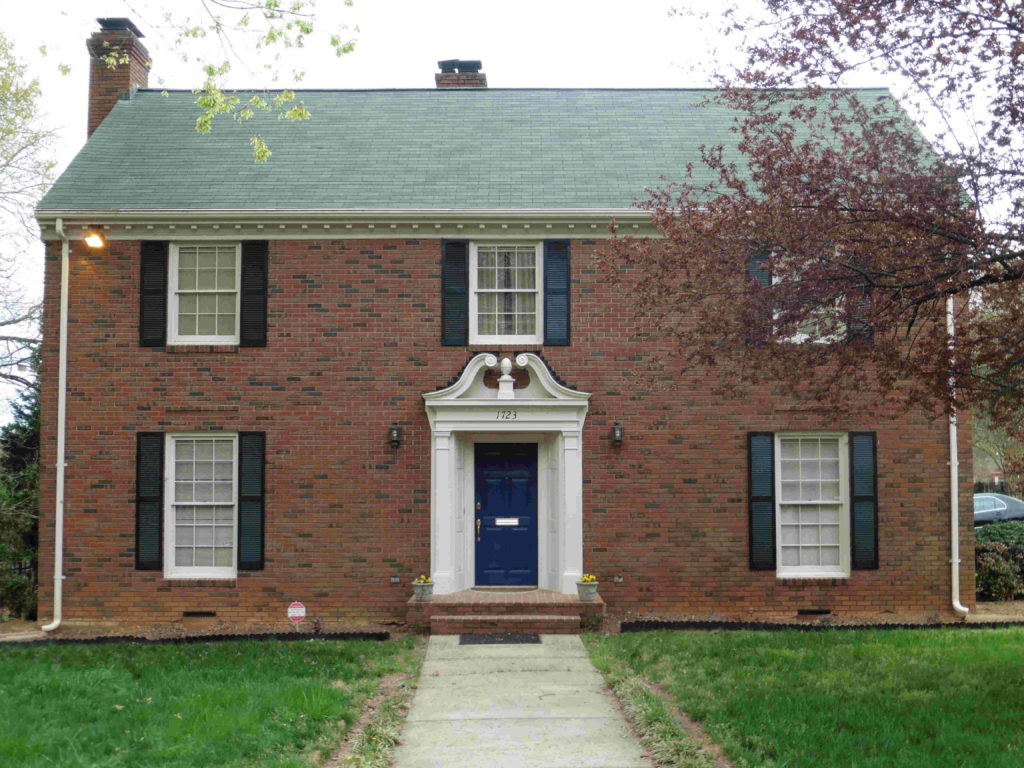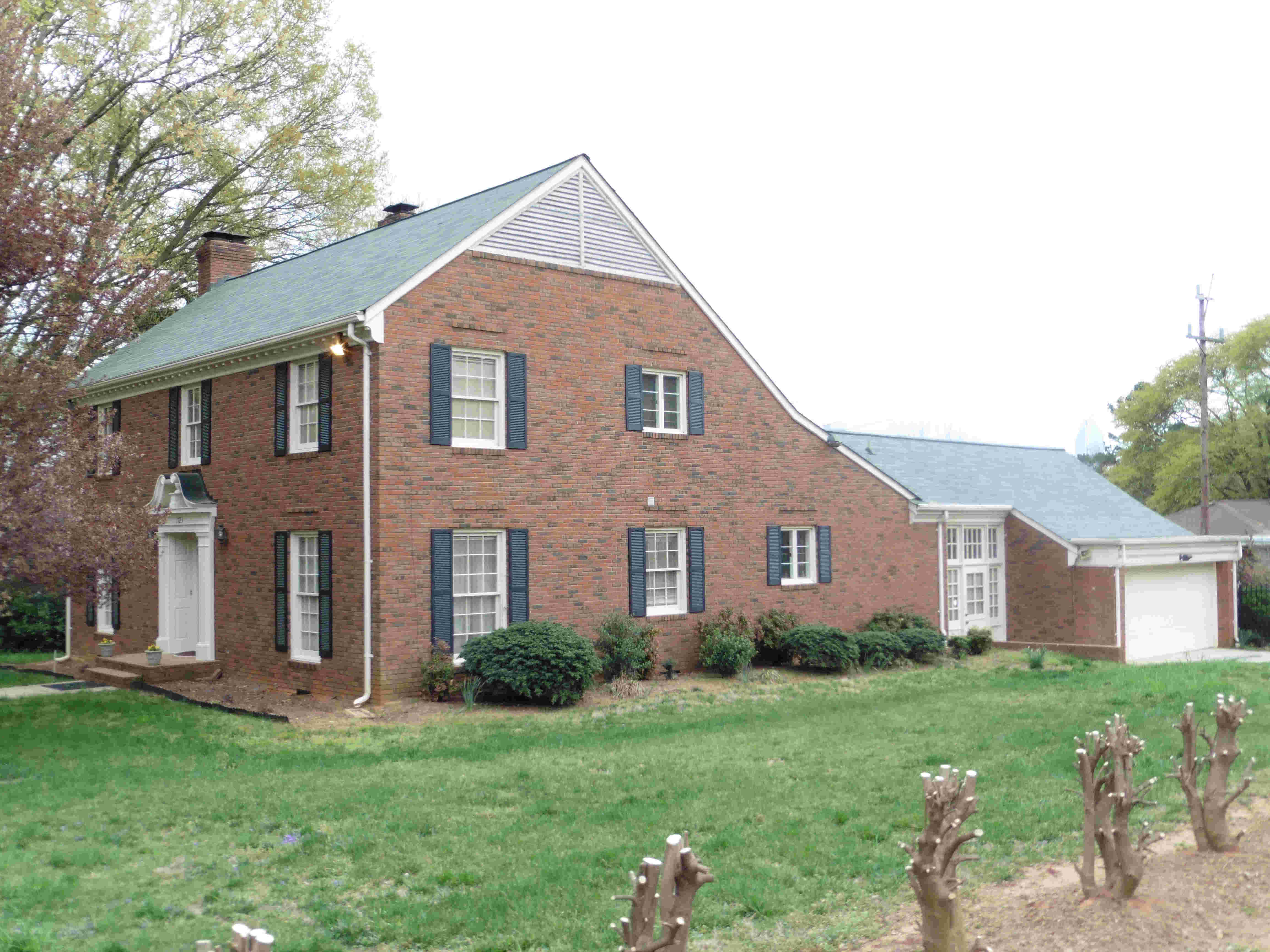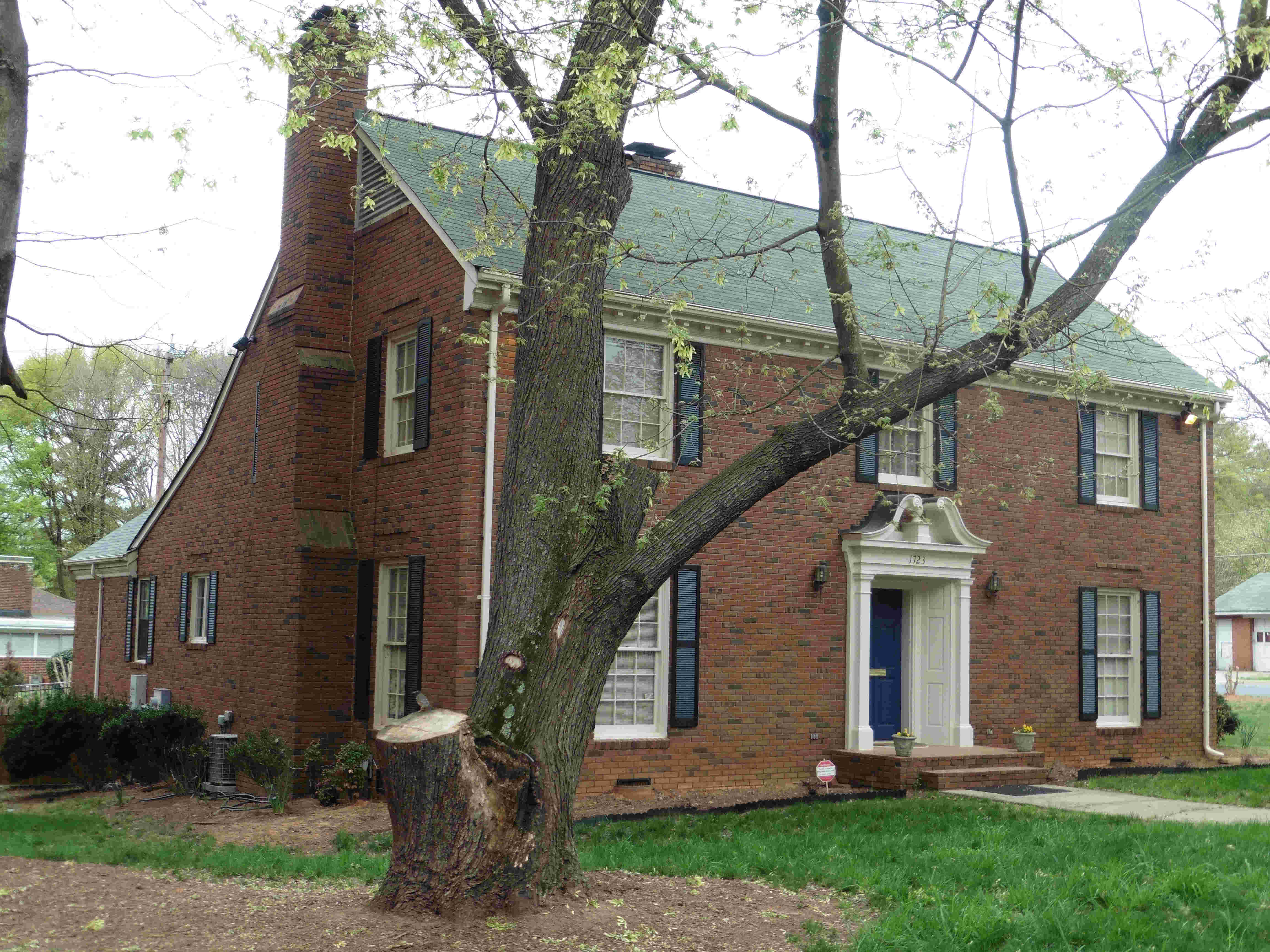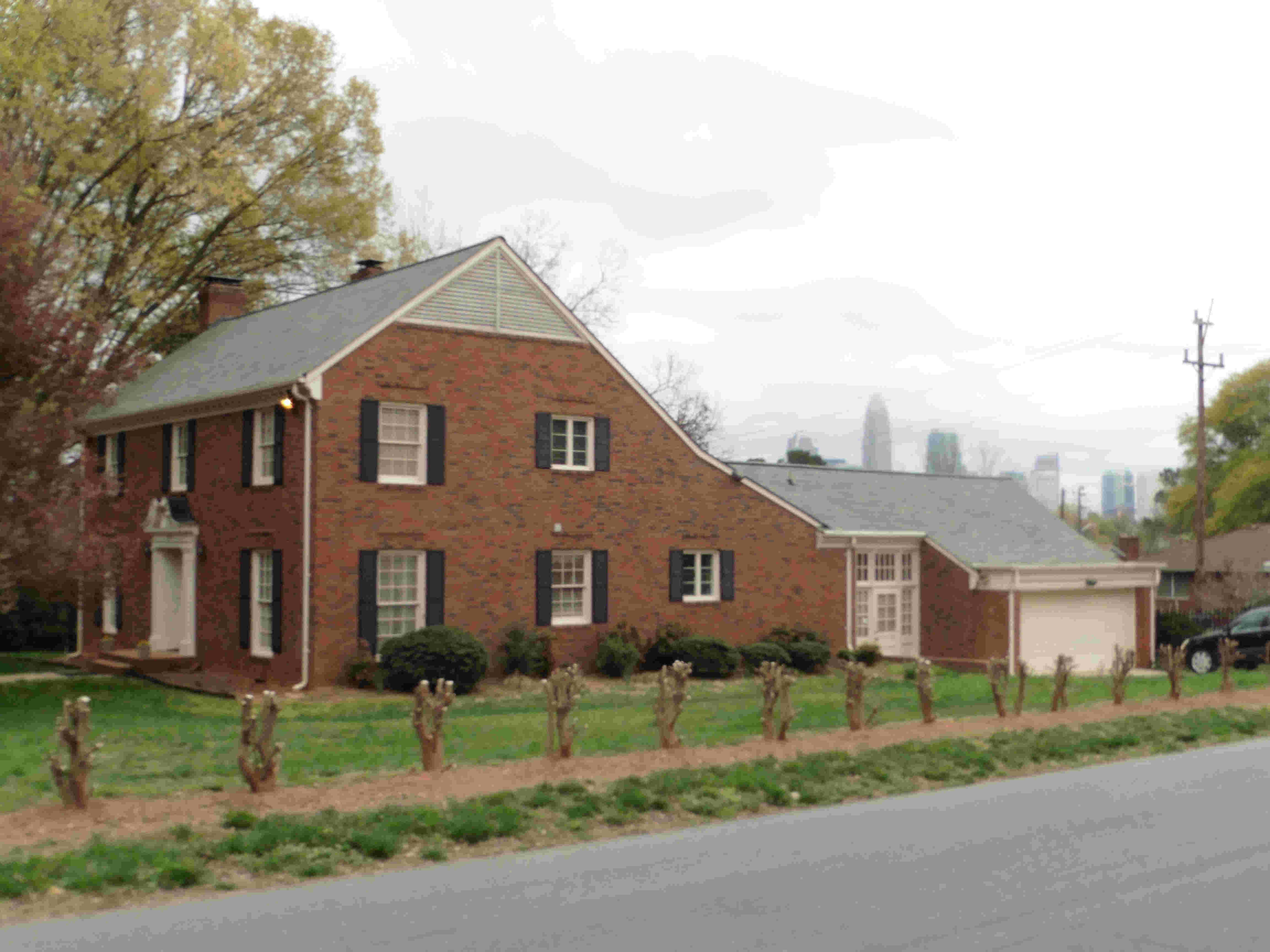1723 Washington Avenue
 Built 1965 – 1966 as the President’s House for Johnson C. Smith University, first occupied by Dr. Rufus Perry, president of Johnson C. Smith University 1957 – 1968. An energetic fund-raiser and long-range planner, he led the construction of key new buildings on campus including Brayboy Gymnasium, Duke Library, Memorial Student Union, and the Perry science center. He is remembered as JCSU’s “master builder.”
Built 1965 – 1966 as the President’s House for Johnson C. Smith University, first occupied by Dr. Rufus Perry, president of Johnson C. Smith University 1957 – 1968. An energetic fund-raiser and long-range planner, he led the construction of key new buildings on campus including Brayboy Gymnasium, Duke Library, Memorial Student Union, and the Perry science center. He is remembered as JCSU’s “master builder.”
* * *
Georgia-born Rufus Patterson Perry ( – 2.22.1984) graduated from JCSU in 1925, then earned an M.A. (1927) and PhD (1939) at University of Iowa. He built a career as a “distinguished science scholar,” in the words of Jet Magazine. He chaired the department of Natural Sciences at historically black Prairie View A & M College in Texas before being recruited back to Charlotte to become JCSU’s eighth president, the first who was not a Presbyterian minister. “He is credited with increasing Smith’s enrollment from 600 to more than 1200 and raised funds for the construction of seven buildings on campus,” Jet reported. The new facilities were: Jack S. Brayboy Gymnasium (1960), Hardy Liston Residence Hall for women (1962), University Memorial Union (1965), Duke Memorial Library (1967), Myers Residence Hall for men (1967), Sanders Residence Hall for women (1967) and the Rufus P. Perry Science Annex (1968).
President Perry was at the helm when the Sit-In Movement erupted in 1960. Sparked by students from NC A&T University on February 1, it spread quickly to other HBCUs first in North Carolina, then beyond. Charlotte’s Sit-Ins were among the largest, with as many as 200 young people marching downtown again and again to occupy seats in the whites-only lunch counters and politely ask to be served. JCSU students Charles Jones, B.B. DeLaine and Heyward Davenport organized the effort which continued for nearly six months before the restaurants opened to all. Officials at some other colleges opposed the Sit-Ins; the protests not only broke segregation laws, but also jeopardized whatever small influence that black college officials had with the white establishment. Rufus Perry, however, supported his students. “For thirty years as a Negro educator, I had been involved in teaching human dignity, Christian brotherhood, the principles of freedom. When these young people went out, I certainly could not say to them, no,” he told journalist Pat Watters. He counseled the students to avoid being arrested and used his connections with the police and merchants to aid the negotiations. “I insisted always that the students conduct themselves as ladies and gentlemen — and they did. Their poise in the face of profanity, being spat upon … I don’t know whether I could take that.” Indeed, Perry viewed the Sit-Ins as a culmination of JCSU’s mission: “It was possible then for the first time for the nation to see the results of sound wholesome training in Negro colleges of the South. What the students were doing reflected that which had been deep in the educational philosophy of such schools during the ninety to ninety five years they have been in existence.”
Upon retiring from JCSU in 1968, Dr. Perry moved to Washington, D.C., where he served as a consultant to the National Science Foundation and the U.S. Office of Education. He married Thelma D. Perry, a JCSU professor of African American history who had a career of national note. Born in Oklahoma, she earned degrees in history and law from Howard University in Washington, D.C., and did graduate work at American University and University of Chicago. She practiced law early in her career, then focused on college teaching, which brought her to JCSU. In 1970, after marrying Dr. Perry and moving to Washington, she joined the staff of the Negro History Bulletin (now the Journal of African American History), retiring in the late 1980s as its Associate Editor.
Subsequent JCSU presidents who resided in the house at 1723 Washington Avenue included Lionel Newsome (served 1968 – 72), Wilbert Greenfield (1973 – 82) and Robert Albright (1983 – 94).



Architecture
A stately example of the Colonial Revival style, two stories tall in red brick, located on a prominent corner lot. The house has a main two-story block under a gable roof, with the roof’s slope extending downward at the back in “saltbox” fashion to create a one-story rear area. A one-story wing beyond that, under a transverse gable roof, holds the two-car garage. The trim of the house includes such Colonial touches as
- dentil molding under the front eaves
- 6-over-6 pane sash windows upstairs and 9-over-9 downstairs, all flanked by shutters
- a “broken” pediment and pilasters framing the front door
And there is a prominent exterior chimney at the east side of the dwelling.
The use of Colonial Revival design — a favorite style during the 1960s — conveyed patriotism, stability and faith in America. It was common in upscale white neighborhoods such as older Myers Park, home to many of the white funders and civic partners whom President Perry needed to cultivate. The substantial new house signaled that Dr. Perry was a man of achievement who deserved the respect of all.
Designed by Charlotte’s leading architecture firm, A.G. Odell, Jr. & Associates, which also designed the JCSU’s library, student union and Brayboy Gymnasium at about the same time. Constructed by Vinroot Construction; Vinroot’s son Richard would become a Republican Mayor of Charlotte 1991 – 1995 known for his strong interest in African American issues.
Building permits
Washington-1723-permit
Date issued: December 6, 1965
Owner: Johnson C, Smith University
Architect: AG Odell, Jr., & Associates
Contractor: G.E. Vinroot Construction.
Estimated cost: $53,000
Other permit info: build residence. 3,200 square feet.
First appeared in city directory
1967 Rufus P. Perry & Thelma D.
He: President, JCSU. She: Assoc Prof., JSCU.
1981 Wilbert Greenfield & Felicia
He: President, JCSU
Resources
“Dr. Rufus Patterson, 80, Ex J.C. Smith U. Prexy,” Jet Magazine, March 19, 1984.
Durden, Robert F., Lasting Legacy to the Carolinas: The Duke Endowment, 1924 – 1994. (Duke University Press, 1998), pp. 225 – 231.
Perry, Thelma D., obituary. Washington Post, November 29, 2000. On-line at: https://www.washingtonpost.com/archive/local/2000/11/29/thelma-perry-94/1472ebc4-233b-4852-8301-08d877b65dca/?utm_term=.daeb062e4a00
Watters, Pat, Down to Now: Reflections on he Southern Civil Rights Movement (University of Georgia Press, 1993), pp. 76-77.